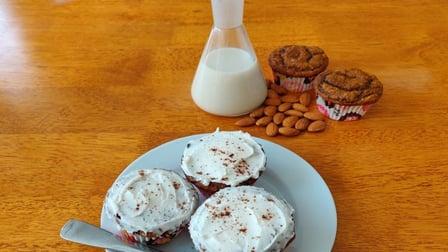MOOC List is learner-supported. When you buy through links on our site, we may earn an affiliate commission.

MOOC List is learner-supported. When you buy through links on our site, we may earn an affiliate commission.
These are just some of the recipes that are available in Samita Sarkar's vegan dessert book, Taste Tests -- and a couple that aren't!
Because baking is just as much a science as an art, this course also includes short, digestible scientific tidbits explaining the chemistry of the recipes and the ingredients, and why they react the way that they do.
Format of the Course:
Part 1: The Icing on the Cake
Watch the white and fudge frosting recipes. Download the "Breakdown on Sugar" PDF in the resources section.
Part 2: A Simple Cake from Scratch
Watch the Acid-Base and Simple Cake videos. You may start thinking about your project at this time.
Part 3: Cookie Chemistry
Watch the shortbread and gingerbread cookie recipe videos, and download the PDF on aromatics.
A bonus activity explaining moles and molecules (and how to use these concepts to discover baking ratios) is available for download as well. As an added challenge, you can complete the activity to find the shortbread measurements without needing to even watch the lesson! This is a good practice activity for students who are interested in science.
Part 4: Chocolate Goodness
In this section, we learn to make chocolate goodies: marble cake, brownies, and lemon chocolate cupcakes. Please download the corresponding resources on Flowers and Flour (marble cake), Photosynthesis (brownies), and Vitamin C (lemon cupcakes).
Part 5: Home Style Comforts
Finally, we learn to make comfort foods: cinnamon rolls and pie. Please watch these remaining videos, and help yourself to the corresponding downloads on Aerobic Respiration (cinnamon rolls) and Pigments (cherry pie) while you also help yourself to a serving of one of your creations!
Armed with your new baking skills and knowledge of kitchen chemistry, you're ready to finish your project and share the pictures -- or even the final product itself! ;)
Follow the steps to plan and bake your own vegan dessert!
1. Would you like to bake a single-layer, 8-inch diameter cake, or approximately 8 cupcakes?
First, place 1 cup of flour into a bowl. If you'd like to bake a cake, get an 8-inch baking pan or a small pie plate ready.. If you'd like to make cupcakes, get the muffin tin.
2. Add 2 tbsp. of baking powder and 1/2 tsp. of baking soda to the flour in the bowl.
3. Choose any 2 of the following to flavour the dessert:
(Set your choices aside on the kitchen counter, but do not add them to the bowl yet.)
- 1/2 c. blueberries (fresh or frozen)
- 1/3 c. mini chocolate chips
- 1/3 c. dried fruits, such as cranberries
- 1 tsp. vanilla extract
- 1/2 tsp. almond extract
- 1/4 c. crushed nuts or almond slivers
- 1/2 tsp. cinnamon
- 2 tsp. orange rind
4. Choose 1 from the following liquids:
- almond or another nut-based milk
- soy milk
- coconut milk
- coconut water
- fruit juice
- water (not recommended -- the end product may be bland)
5. Choose one of the following sweeteners:
- maple syrup
- agave syrup
- date syrup
- coconut sugar
- brown sugar
6. Now that your ingredients are chosen and are laid out on the counter, you may pre-heat the oven to 350 F.
7. Get a measuring cup. Add any dry ingredients from Step 3 into the bowl with the cake/cupcake mix, and then rinse out the cup.
8. Using the measuring cup, measure 1/3 c. sweetener of your choosing, and 1/2 c. of the liquid of your choosing. Add 3 tbsp. vegetable oil. Add any wet ingredients from Step 3, if applicable. Once this is all measured, stir the wet ingredients together in a cup or bowl, then add them to the bowl with the cake/cupcake batter. Continue to stir the bowl for a minute or so.
Note that if you chose coconut sugar or brown sugar as the sweetener, you will need 3/4 c. of the liquid of your choosing, not 1/2 c.
9. Pour the batter into the baking pan or muffin tin, and bake for approximately 25 minutes if making a cake, and 15 if making cupcakes. Keep an eye on the oven, as every oven is different and the individual baking time will vary based on the ingredients chosen.
10. While the dessert is baking, choose one of the following toppings:
- white frosting (see recipe lesson or PDF)
- fudge frosting (see recipe lesson or PDF)
- jam or marmalade
- nut butter
- glaze (1 c. icing sugar + 1 tbsp. water, almond milk, or the liquid of your choice)
11. BONUS (OPTIONAL): You may sprinkle 1 or 2 of the following on top of the icing for added decoration of your cakes or cupcakes.
- coconut shavings
- cinnamon to taste
- crushed nuts
- chocolate chips
- sprinkles!
Once your dessert has baked (lightly browned on top, with a toothpick coming out clean), decorate it as desired, and take a picture for us to see in your project section!
MOOC List is learner-supported. When you buy through links on our site, we may earn an affiliate commission.
MOOC List is learner-supported. When you buy through links on our site, we may earn an affiliate commission.
